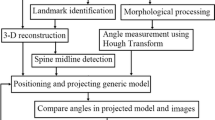Abstract
Several 3D reconstruction techniques deriving from stereoradiographic DLT have been presented during the last 15 years, but these techniques have usually been limited in accuracy because of the small number of corresponding anatomical landmarks identified on both radiographs. A new technique has recently been proposed to perform 3D reconstruction of the spine using not only the stereo-corresponding anatomical landmarks (seen on both frontal and sagittal X-ray films) but also some non-stereo-corresponding ones. This technique (called non-stereo-corresponding points or NSCP) has already been used for cervical dry vertebrae. In the present study, we focus on the validation of this technique for lumbar vertebrae by comparing four techniques: direct measurement, CT scan, 3D reconstruction by stereoradiography using a direct linear transformation (DLT) algorithm and the NSCP technique. The accuracy of the NSCP technique was also evaluated on different vertebral regions. The global results show mean errors of 1.1 mm and maximum of 7.8 mm with regard to direct measurements. These mean errors are close to those obtained using 3D reconstructions from CT scan using 1 mm cuts.
Similar content being viewed by others
References
Abdel-Aziz, Y. I., andKarara, H. M. (1971): ‘Direct linear transformation from comparator coordinates into object space coordinates in close range photogrammetry’. Proc. ASP/UI Symposium on Close-range Photogrammetry, Urbana, Illinois.
André, B., Dansereau, J., andLabelle, H. (1994): ‘Optmized vertical stereo base radiographic setup for the clinical three-dimensional reconstruction of the human spine’,J. Biomech.,27, pp. 1023–1035
Aubin, C. E., Dansereau, J., Parent, F., Labelle, H., andDe Guise, J. A. (1997): ‘Morphometric evaluations of personalized 3D reconstructions and geometric models of the human spine’,Med. Biol. Eng. Comput.,35, pp. 611–6184
Chen, L., Armstrong, C. W., andRaftopolous, D. D. (1994): ‘An investigation on the accuracy of the three-dimensional space reconstruction using the direct linear transformation’,J. Biomech.,2, pp. 493–500
Dangerfield, P. H. (1992): ‘Scoliotic curves types should be reclassified using 3-D measurements’. Proc. Int. Symp. 3-D Scoliotic Deformities, Montréal, Québec, Canada
Dansereau, J., andStokes, I. A. (1988): ‘Measurements of the three-dimensional shape of the rib cage’,J. Biochem.,21, pp. 893–901
De Guise, J. A., andMartel, Y. (1988): ‘3D biomedical modeling: merging image processing and computer aided design’. IEEE EMBS 10th Int. Conf., New Orleans, pp. 426–427
Delorme, S. (1996): ‘Application du krigeage pour l'habillage et la personnalisation de modèle géométrique de la scoliose’. Mémoire de maîtrise, Ecole Polytechnique de Montréal
Drerup, B. (1992): ‘3-D acquisition, reconstruction and modelling techniques applied on scoliotic deformities’. Proc. Int. Symp. 3-D Scoliotic Deformities, Montréal, Québec, Canada, pp. 2–10
Dubousset, J. (1992): ‘Importance of the three-dimensional concept in the treatment of scoliotic deformities’. Proc. Int. Symp. 3-D Scoliotic Deformities, Montréal, Québec, Canada, pp. 302–311
Gazzani, F. (1993): ‘Comparative assessment of two algorithms for calibrating stereophotogrammetric systems’,J. Biomech.,26, pp. 1449–1454
Goel, K. V., Kim, Y. E., Lim, T. H., andWeinstein, J. N. (1988): ‘An analytical investigation of the mechanics of spinal instrumentation’,Spine,13, pp. 1003–1011
Hatze, H. (1988): ‘High-precision and three-dimensional photogrammetric calibration and object space reconstruction using a modified DLT-approach’,J. Biomech.,21, pp. 533–38
Koubaa, W., Defives, T., Pierunek, M., Simonet, J., Skalli, W., andLavaste, F. (1995): ‘Modelisation tridimensionnelle par éléments finis de la jonction thoraco-lombaires (T12-L1)’,Rachis,7, pp. 181–196
Landry, C., De Guise, J. A., Dansereau, J., Labelle, H., Skalli, W., Zeller, R., andLavaste, F. (1997): ‘Analyse infographique des déformations tridimensionelles des vertèbres scoliotiques’,Ann. Chir.,51, pp. 868–874
Laporte, S., Mitton, D., De Fouchecour, M., Lasseau, J. P., Lavaste, F., andSkalli, W. (2000): ‘Quantitative morphometric study of thoracic spine. A preliminary parameters statistical analysis’,Eur. J. Orthop. Surg. Traumatol.,10, pp. 85–91
Lavaste, F., Skalli, W., Robin, S., Roy-Camille, R., andMazel, C. (1992): ‘Three-dimensional geometrical and mechanical modelling of the lumbar spine’,J. Biomech.,25, pp. 1153–1164
Le Borgne, P., Skalli, W., Stokes, I. A. F., Maurel, N., Duval Beaupère, G., andLavaste, F. (1995): ‘Three-dimensional measurement of a scoliotic spine’ inD'Amico, M. (Ed.): ‘Three-dimensional analysis of spinal deformities’ (IOS Press, Amsterdam)
Levy, A. R., Goldberg, M. S., Mayo, N. E., Hanley, J. A., andPoitras, B. (1996): ‘Reducing the life-time risk of cancer from spinal radiographs among people with adolescent idiopathic scoliosis’,Spine,21, pp. 1540–1548
Marzan, G. T. (1976): ‘Rational design for close-range photogrammetry’, Ph D thesis, Department of Civil Engineering, University of Illinois at Urbana-Champaign, USA
Mitton, D., Landry, C., Véron, S., Skalli, W., Lavaste, F., andDe Guise, J. A. (2000): ‘A 3D reconstruction method form biplanar radiography using non stereocorresponding points and elastic deformable meshes’,Med. Biol. Eng. Comput.,38, pp. 133–139
Nyström, L., Söderkvist, I., andWedin, P. A. (1994): ‘A note on some identification problems arising in roentgen stereo photogrammetric analysis’,J. Biomech.,27, pp. 1291–1294
Pearcy, M. J. (1985): ‘Stereo radiography of lumbar spine motion’,Acta Orthop Scand.,212, pp. 1–45
Perdriolle, R. (1979): ‘La scoliose’ in Maloine (Ed.) (Paris, 1979)
Semaan, I. (1997): ‘Etude morphométrique des vertèbres lombaires; Mémoire de DEÁ (ENSAM, Paris)
Shirazi-II, A., Ahmed, A. M., andShrivastava, S. C. (1986): ‘A finite element study of a lumbar segment subjected to pure sagittal plane moments’,J. Biomech.,18, pp. 2–19
Skalli, W., Robin, S., Lavaste, F., andDubousset, J. (1993): ‘A biomechanical analysis of short segment spinal fixation using a three-dimensional geometric and mechanical model’,Spine,18, pp. 536–545
Trochu F. (1993): ‘A contouring program based on dual kriging interpolation’,Eng. Comput.,9, pp. 160–177
Ueno, K., andLiu, Y. K. (1987): ‘A three-dimensional nonlinear finite element model of the lumbar intervertebral in torsion’,J. Biomech. Eng.,109, pp. 200–209
Véron, S. (1997): ‘Modélisation géométrique et mécanique tridimensionelle par éléments finis du rachis cervical supérieur’. Thèse de doctorat en mécanique, ENSAM, Paris
Author information
Authors and Affiliations
Corresponding author
Rights and permissions
About this article
Cite this article
Mitulescu, A., Semaan, I., De Guise, J.A. et al. Validation of the non-stereo corresponding points stereoradiographic 3D reconstruction technique. Med. Biol. Eng. Comput. 39, 152–158 (2001). https://doi.org/10.1007/BF02344797
Received:
Accepted:
Issue Date:
DOI: https://doi.org/10.1007/BF02344797




